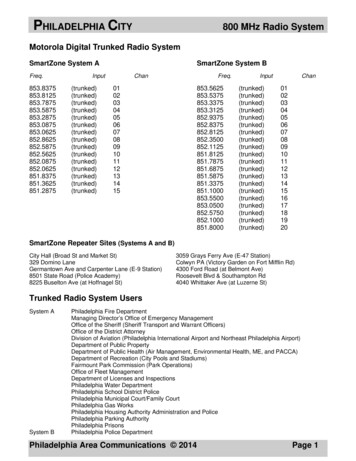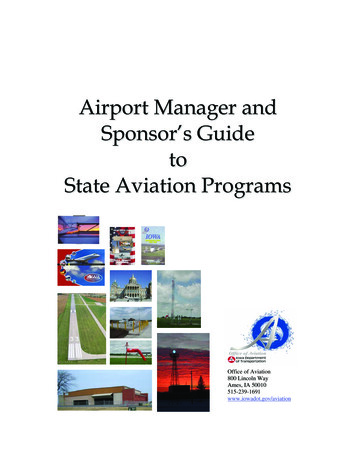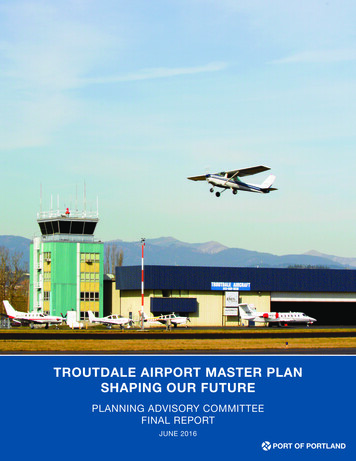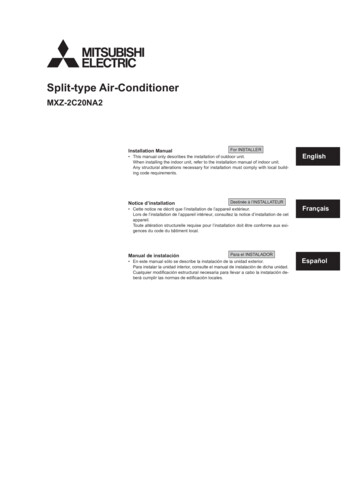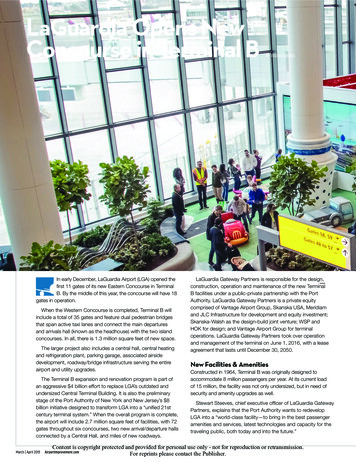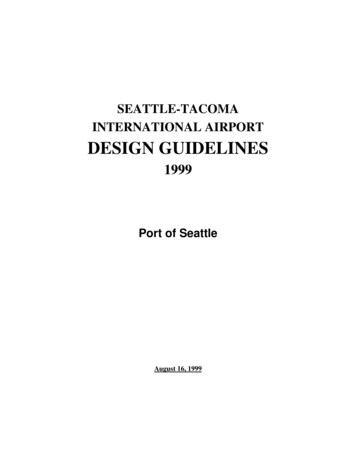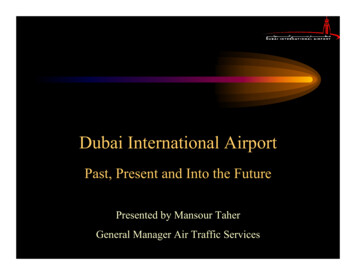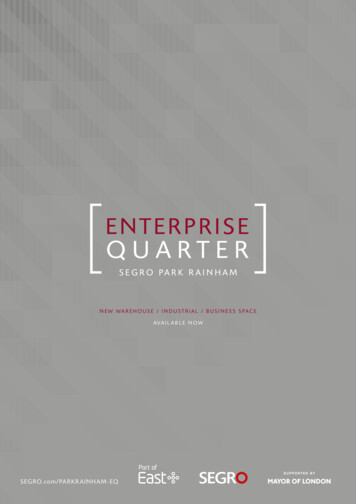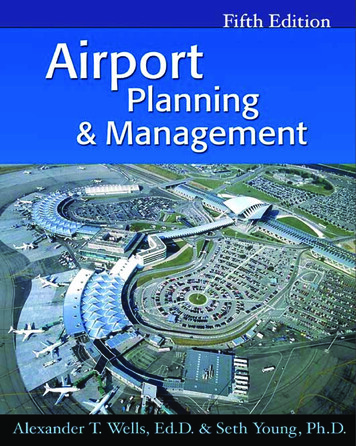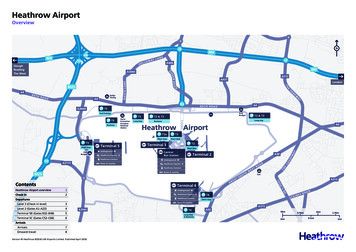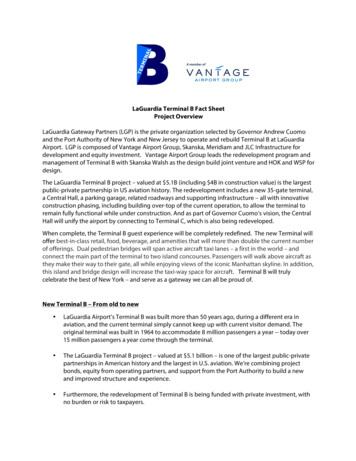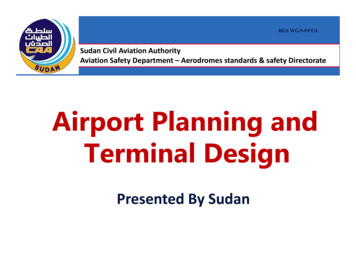
Transcription
RGS WG/5-PPT/4Sudan Civil Aviation AuthorityAviation Safety Department – Aerodromes standards & safety DirectorateAirport Planning andTerminal DesignPresented By Sudan
Reference RGS/W4AGENDA ITEM 3Implementation of Aerodrome Safety Prioritiesand objectives in the MID Region conclusion 4/6Regarding Airport Master Planning. Airport Manual (Doc. 9184.Part 1).November 2018(RGS WG/5)2
Outline An overview of Airport Master Planningbased on ICAO planning guidelines. What an airport master plan entail. Emphasis on concepts andconsiderations from the executives’perspective.November 2018(RGS WG/5)3
Definition of AirportMaster Plan Concept of the ultimate development of a specificairport, graphically presented with written report to effectivelyconvey the research and logic from which the plan was evolved(ICAO Manual). Long‐term development concept of an airport; anembodiment of the airport’s strategic framework and conceptdepicted graphically and documents the data and logic uponwhich the plan is based. Guidelines for future airport development tosatisfy aviation demands in a financially feasiblemanner, while addressing aviation, environmental andsocioeconomic issues in the local community.November 2018(RGS WG/5)4
Airport Master Plan Establishing short and long range policy/decision. Developing physical facilities of an airport – aviationnon‐aviation. Developing land uses surrounding airport. Determining environmental effects of airport.construction and operation. Establishing access requirements of the airport. Identifying potential problems as well as opportunities. Securing financial aid. Establishing basis for negotiations of interests andneeds among aerodrome authority, businesses5and community.November 2018(RGS WG/5)
Changi Airport MasterPlanNovember 2018(RGS WG/5)6
Stakeholders of AirportMaster Plan Airports are multi‐faceted facilities, impacting awide spectrum of people and businesses Need for consultation and coordination ofplanning with stakeholders concerned :o Airlines.o National and local government planners .o Government control authorities (immigration, customs,health).o National and local transport authorities.o Aircraft and equipment manufacturers.o International aviation agencies and businesses.o Concessionaires.o Local business and residential communities.November 2018(RGS WG/5)7
Airport Master PlanningPhilosophy A good Airport Master Plan represents the mostefficient framework with flexibility, expandabilityand optimum balance of all individual airportfacilities/services to provide the required capacityfor aircraft, pax, cargo and vehicular movementswith max facilitation for pax, operator and staff atlowest capital and operating costs and maxrevenue. Generates higher capacity and efficiency througha series of compromises than would otherwise beattained without reconciliation of individualfacilities plans.November 2018(RGS WG/5)8
Airport Master PlanningPhilosophy Cont.IN ALL CASES, COMPROMISESDO NOT AFFECT SAFETYNovember 2018(RGS WG/5)9
Airport Master PlanningProcess Involves preparation of broad and specific policies, plansand programs. Goals of Planning process to:– Orderly and timely develop airport to meet presentand future air transportation needs.– Coordinate local, regional and national plans.– Protect and enhance environment (noise, pollution).– Establish effective airport organisation for implementation.– Ensure compatibility with state/country aviation,ICAO and IATA standards.November 2018(RGS WG/5)10
Airport Master PlanningProcess Cont.– Coordinate national and regional airport systems.– Coordinate plans for nav. facilities, airspace andair traffic control procedures.– Optimize use of land and airspace resources . Policy/Coordinative Planning– Project goals, objectives.– Develop work programmes, schedules andbudgets.– Prepare and evaluation and decision format.– Establish coordination and monitoring procedures.– Establish data management and publicinformation system.November 2018(RGS WG/5)11
Airport Master PlanningProcess Cont. Economic Planning– Prepare analysis of aviation market characteristicsand forecasts of aviation activity.– Determine representative benefits and costsassociated with airport development alternatives.– Prepare an assessment of impact on areaeconomy of various alternatives.November 2018(RGS WG/5)12
Airport Master PlanningProcess Cont. Physical Planning–––––––Airspace and air traffic control provisions.Airfield configuration (including approach zones).Terminal complex.Circulation, utility and communications networks.Support and service facilities.Ground access systems.Over‐all land use patterns.November 2018(RGS WG/5)13
Airport Master PlanningProcess Cont. Environmental Planning– Prepare an assessment of natural environmentalconditions associated with the airport “impact”area (plant and animal life, climate, topographyand natural resources, etc).– Document present and projected developmentpatterns of relevance to the impact area.– Determine community attitudes and opinions.November 2018(RGS WG/5)14
Airport Master PlanningProcess Cont. Financial Planning– Determine airport funding source and constraints.– Prepare a financial feasibility study of variousairport development alternatives.– Prepare preliminary financial plans and programmesfor the finally agreed upon concept.November 2018(RGS WG/5)15
Airport Master PlanningProcess Cont. Reviews– Annually and adjust plans according to prevailingconditions.– Thorough evaluation and modification every fiveyearly or more often if changes in economic,operational and environmental and financialconditions dictates.November 2018(RGS WG/5)16
Steps in Planning Process Prepare work program and identify responsibilities.Inventory and document existing conditions.Forecast future air traffic demand.Determine facility requirements and preliminary time phaseddevelopment.Evaluate existing and potential constraints.Prioritize considerations (constraints, airport type).Develop concepts.Assess operational, financial and environmental impactof concepts (reiterations).Select most acceptable and appropriate alternatives,modify and finalize.November 2018(RGS WG/5)17
Air Traffic Forecasts Forecasts parameters– Annual pax, cargo, mail throughput (int’l/dom;scheduled/ non‐scheduled; arrival/departure,transit/transhipment .– Typical peak hour aircraft movements and pax,cargo, mail throughput (arrivals/departure/combined).– Average day of peak month aircraft movements andpax, cargo, mail throughput.– No. of airlines, fleet mix, load factors, routestructures.– No. of base aircraft (scheduled/non‐scheduled/GA).– No. of visitors and airport workers.November 2018(RGS WG/5)18
Forecast Relationship vsMaster PlanNovember 2018(RGS WG/5)19
Forecasts Techniques Informed judgementDepends on experience and credibility of forecaster,subjective, immediate term. Trend extrapolationAssumes all past factors influencing aviation trafficdemand will continue to operate with same impactin future, best fit curve, short term.November 2018(RGS WG/5)20
Forecasts TechniquesCont. Econometric modelling– Based on derived quantitative relationship betweentraffic and important underlying factors affecting traffic.– A few quantifiable major factors influencing airtransport demand can explain most of traffic demandvariation.– Real economic growth, real air fares, real energy prices,tourism gorwth and consumer demographics deemed tobe most important factors impacting aviation growth.– Relatively effective for short and medium termforecasts.November 2018(RGS WG/5)21
Forecasts TechniquesCont. Market survey (Cross Classification Method)– Obtains primary data from source of airportdemand.– Surveys covering extensive user network toeliminate bias, expensive and needs properstructuring.– Assumes stable relationship between travel patternand socioeconomic characteristics.November 2018(RGS WG/5)22
Airport Master PlanObjective Developing an airport plan with a layout thatyields optimum airport capacity withinavailable land to meet future demand andinternational operating standards. Delay and processing times associated withdifferent facilities and components in themaster plan impact capacity.November 2018(RGS WG/5)23
Airport Master PlanObjective Cont. Factors that affects capacity include:– Airfield configuration (runway, taxiway ,gates/parking positions).– Operating environment.– Navaids and ATC facilities (availability of navaids,airspace, arrival and departure routes, extent ofATC facilities approach/departure control tower) .November 2018(RGS WG/5)24
Airfield Configuration Runway Configuration.– Orientation.– Number of runways. Taxiway Layout. Terminal / Apron Area. Aircraft Parking Configuration. Cargo Terminal.November 2018(RGS WG/5)25
Airfield ConfigurationConcept Runways No. of runways depends on volume of aircraft movements. Orientation of runway depends on direction of prevailingwinds. Runway length is influenced by temperature, runwayslope, airport altitude, MTOW, runway pavement condition,visibility. Airspace around airport should remain free of obstacles topermit safe aircraft operations.November 2018(RGS WG/5)26
Airfield ConfigurationConcept Cont. Runway Orientation Aircraft are not directed over populated areasand avoid obstructions. Oriented in the direction of the prevailingwind and cross wind is not too excessive.November 2018(RGS WG/5)27
Airfield ConfigurationConcept Cont. Annex 14 specifies that runways should beoriented so aircraft may be able to land at least95% of the time with cross wind components. Good visibility.November 2018(RGS WG/5)28
Airfield ConfigurationConcept Cont. Runway Configurationo Achieve safe aircraft operations, ensure:‐– Adequate separation between air traffic streams.– Obstacle clearance.– Crosswind provision.o Ensure least interference and delay tooperations.o Avoid noise and sensitive areas.November 2018(RGS WG/5)29
Airfield ConfigurationConcept Cont. Single runwaypreferable to locate terminal equi‐distance to runwayends or shift it if there is predominant direction ofoperations 2‐parallel runways (single orientation)o Optimum capacity and best air traffic control efficiencyo Mid‐field terminal between runways preferredo Terminal on one side of runways lead to longer taxiingdistances and runway crossing problemso Runways may be staggeredNovember 2018(RGS WG/5)30
Airfield ConfigurationConcept Cont. Runways with 2 alignmentso Open configuration preferred with diverging operationsused whenever possible.o If intersecting configuration is unavoidable and there ispredominant direction in aircraft operations, runwaysshould have a rear intersection for that direction.o Centrally located terminal to minimize taxi distance.November 2018(RGS WG/5)31
Airfield ConfigurationConcept Cont. Taxiwayso Taxiways to be arranged to minimizeinterference between landing aircraft andaircraft taxiing to takeoff.o Parallel taxiways increase runway capacity.o Shortest taxi distance from passengerterminal apron to runway ends.November 2018(RGS WG/5)32
Airfield ConfigurationConcept Cont. Taxiway Layout Guidelineso Efficient connection between runways andterminal / service areas.o Avoid conflicts between aircraft operations Arriving and departing taxi routes.Holding passes and bypasses.o Avoid crossing of active taxiways over active runways.o Minimize runway occupancy time of arrivingaircraft (eg strategically located rapid exittaxiways enable landing aircraft to leave runwayquickly for other aircraft).November 2018(RGS WG/5)33
Airfield ConfigurationConcept Cont.o Terminal/Apron location Minimum taxiing distance to and from runways. Avoid locations under aircraft approach ordeparture paths.November 2018(RGS WG/5)34
Taxiway LayoutNovember 2018(RGS WG/5)35
Typical AirportConfigurationNovember 2018(RGS WG/5)36
Typical AirportConfigurationNovember 2018(RGS WG/5)37
Airfield ConfigurationConcept Cont. Apronso Account for the safety procedures ofaircraft maneuvering on the apron.o Allow efficient aircraft movements anddispensing apron services.o Flexible to accommodate different sizeof aircraft types and future expansionneeds.November 2018(RGS WG/5)38
Parking Configuration 1November 2018(RGS WG/5)39
Parking Configuration 2November 2018(RGS WG/5)40
Airport Site Selectiono Determine purpose for which airport is required .o Consider forecast future demands (operationaland economic) and quantity and type of traffic .o Define type of airport and operational systems forforecast traffic .o Major steps to consider :– Selection of site that provides adequate space and sizeand suitable locations to serve the residents andcommerce .– Evaluation of feasibility of possible locations through theforecast period from economic, geographic,engineeringand aeronautical standpoints .November 2018(RGS WG/5)41
Airport Site SelectionCont.o Factors influencing airport size:‐––––Performance characteristics and size of aircraft.Anticipated volume and character of traffic.Meteorological conditions like wind and temperature.Elevation of airport site.o Factors influencing airport location:‐– Type and development of surrounding area.– Atmospheric and meteorological conditions (Fog, Haze,turbulence, heavy rainfall).– Accessibility to ground transport (existing highway).– Availability of land for expansion.November 2018(RGS WG/5)42
Airport Site SelectionCont.o Factors influencing airport location (con’t):‐– Presence of other airports and availability of airspace.– Traffic flow patterns of airports (restricted airspace).– Surrounding obstructions (around airports particularlyfor approach and departure paths, obstacle limitationsurfaces).– Economy of construction.– Availability of utilities (electricity, fuel, watersupply etc).– Proximity to aeronautical demand.November 2018(RGS WG/5)43
Environmental Studies Noise Pollution Proper planning of land use for areas surroundingairport. Air Pollution Aircraft engine, exhaust, fuel venting, auxiliary paves unit,fuel storage and ground service tanks, motor vehicles,construction operations. Water Pollution Sanitary wastes, storm water, maintenance wastes andindustrial wastes . Waste water may be treated before discharging, removingsplit oil by containment and spill recovery (absorbent etc).November 2018(RGS WG/5)44
Environmental StudiesCont. Archaeological considerations. Seismic considerations. Inclement weather.November 2018(RGS WG/5)45
Financial Plan Economics and Financial Feasibility. Economic and financials models of alternativemaster plans (iterative process). Master Plan should be targeted to generatesufficient revenues to cover annual costs ofcapital, traffic, operations and maintenanceexpenses. Cost benefit analysis .November 2018(RGS WG/5)46
Hong Kong InternationalAirportNovember 2018(RGS WG/5)47
Changi Airport Terminal 3completion ‐ 2007November 2018(RGS WG/5)48
Heathrow Airport(Interim Master Plan Alt)November 2018(RGS WG/5)49
Thailand InternationalAirportNovember 2018(RGS WG/5)50
thank you!November 2018(RGS WG/5)51
Airfield Configuration Concept Cont. Aprons o Account for the safety procedures of aircraft maneuvering on the apron. o Allow efficient aircraft movements and dispensing apron services. o Flexible to accommodate different size of aircraft types and future expansion needs. November 2018 (RGS WG/5)
